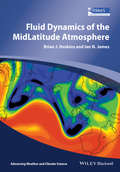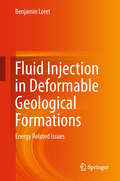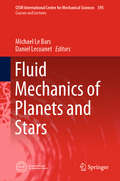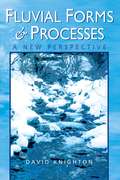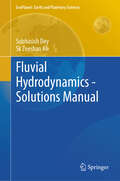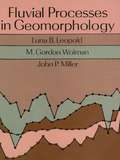- Table View
- List View
Fluid Dynamics for Global Environmental Studies
by Dept. Earth Sys Sci. Tech. Interdis.Grad Sch Engg Sci Kyushu Univ.This book introduces the basic concepts of environmental fluid dynamics. It is intended for use by students, researchers, engineers, and specialists working not only in general fluid research but also in the atmospheric and oceanic research fields. The Earth is covered by atmosphere and oceans and is exposed to solar wind. Therefore, the knowledge of fluid dynamics is essential for tackling its environmental issues. Although many textbooks have treated fluid dynamics, practically no book has been published that clearly describes all essential ideas, from the fundamentals of fluid dynamics to advanced environmental sciences, with careful sequential explanations of the governing mathematics. This book has been developed to solve these educational problems and has actually been in use in lectures in the graduate school of Kyushu University for more than 15 years.
Fluid Dynamics in Physics, Engineering and Environmental Applications
by Jaime Klapp Abraham Medina Anne Cros Carlos A. VargasThe book contains invited lectures and selected contributions presented at the Enzo Levi and XVII Annual Meeting of the Fluid Dynamic Division of the Mexican Physical Society in 2011. It is aimed to fourth year undergraduate and graduate students, and scientists in the field of physics, engineering and chemistry that have interest in Fluid Dynamics from the experimental and theoretical point of view. The invited lectures are introductory and avoid the use of complicate mathematics. The other selected contributions are also adequate to fourth year undergraduate and graduate students. The Fluid Dynamics applications include multiphase flow, convection, diffusion, heat transfer, rheology, granular material, viscous flow, porous media flow, geophysics and astrophysics. The material contained in the book includes recent advances in experimental and theoretical fluid dynamics and is adequate for both teaching and research.
Fluid Dynamics of the Mid-Latitude Atmosphere (Advancing Weather and Climate Science)
by Ian N. James Brian J. HoskinsThis book gives a coherent development of the current understanding of the fluid dynamics of the middle latitude atmosphere. It is primarily aimed at post-graduate and advanced undergraduate level students and does not assume any previous knowledge of fluid mechanics, meteorology or atmospheric science. The book will be an invaluable resource for any quantitative atmospheric scientist who wishes to increase their understanding of the subject. The importance of the rotation of the Earth and the stable stratification of its atmosphere, with their implications for the balance of larger-scale flows, is highlighted throughout.Clearly structured throughout, the first of three themes deals with the development of the basic equations for an atmosphere on a rotating, spherical planet and discusses scale analyses of these equations. The second theme explores the importance of rotation and introduces vorticity and potential vorticity, as well as turbulence. In the third theme, the concepts developed in the first two themes are used to give an understanding of balanced motion in real atmospheric phenomena. It starts with quasi-geostrophic theory and moves on to linear and nonlinear theories for mid-latitude weather systems and their fronts. The potential vorticity perspective on weather systems is highlighted with a discussion of the Rossby wave propagation and potential vorticity mixing covered in the final chapter.
Fluid Dynamics: An Introduction (Graduate Texts in Physics)
by Michel RieutordThis book is dedicated to readers who want to learn fluid dynamics from the beginning. It assumes a basic level of mathematics knowledge that would correspond to that of most second-year undergraduate physics students and examines fluid dynamics from a physicist’s perspective. As such, the examples used primarily come from our environment on Earth and, where possible, from astrophysics. The text is arranged in a progressive and educational format, aimed at leading readers from the simplest basics to more complex matters like turbulence and magnetohydrodynamics. Exercises at the end of each chapter help readers to test their understanding of the subject (solutions are provided at the end of the book), and a special chapter is devoted to introducing selected aspects of mathematics that beginners may not be familiar with, so as to make the book self-contained.
Fluid Dynamics: Fundamentals and Applications
by Guido Visconti Paolo RuggieriThis introductory book addresses a broad range of classical Fluid Dynamics topics, interesting applications, and related problems in everyday life. The geophysical and astrophysical applications discussed concern e.g. the shape and internal structure of the Earth and stars, the dynamics of the atmosphere and ocean, hydrodynamic instabilities, and the different kinds of waves that can be found in the atmosphere, ocean and solid Earth. Non-linear waves (solitons) are also mentioned. In turn, the book explores problems from everyday life, including the motion of golf balls, life at low Reynolds numbers, the physics of sailing, and the aerodynamics of airplanes and Grand Prix cars. No book on this topic would be complete without a look at chaos and turbulence; here the problems span from Gaussian plumes to chaotic dynamos, to stochastic climate modeling. Advances in fluid dynamics have produced a wealth of numerical methods and techniques, which are used in many of the applications. Given its structure, the book can be used both for an introductory course to fluid dynamics and as preparation for more advanced problems typical of graduate-level courses.
Fluid Flow in Fractured Rocks
by Robert W. Zimmerman Adriana PalusznyFLUID FLOW IN FRACTURED ROCKS "The definitive treatise on the subject for many years to come" (Prof. Ruben Juanes, MIT) Authoritative textbook that provides a comprehensive and up-to-date introduction to fluid flow in fractured rocks Fluid Flow in Fractured Rocks provides an authoritative introduction to the topic of fluid flow through single rock fractures and fractured rock masses. This book is intended for readers with interests in hydrogeology, hydrology, water resources, structural geology, reservoir engineering, underground waste disposal, or other fields that involve the flow of fluids through fractured rock masses. Classical and established models and data are presented and carefully explained, and recent computational methodologies and results are also covered. Each chapter includes numerous graphs, schematic diagrams and field photographs, an extensive reference list, and a set of problems, thus providing a comprehensive learning experience that is both mathematically rigorous and accessible. Written by two internationally recognized leaders in the field, Fluid Flow in Fractured Rocks includes information on: Nucleation and growth of fractures in rock, with a multiscale characterization of their geometric traits Effect of normal and shear stresses on the transmissivity of a rock fracture and mathematics of fluid flow through a single rock fracture Solute transport in rocks, with quantitative descriptions of advection, molecular diffusion, and dispersion Fluid Flow in Fractured Rocks is an essential resource for researchers and postgraduate students who are interested in the field of fluid flow through fractured rocks. The text is also highly suitable for professionals working in civil, environmental, and petroleum engineering.
Fluid Injection in Deformable Geological Formations: Energy Related Issues
by Benjamin LoretThis book offers an introduction to the geomechanical issues raised by both the extraction of actual and potential energy resources, and by the treatment of the ensuing environmental concerns. Discussions of the operations of injection of fluids into, and withdrawal from, geological formations link the chapters, each devoted to a particular technical aspect or scientific issue, or to a particular energy resource.Subjects are ordered according to their industrial applications, including enhanced oil and gas recovery, gas hydrates, enhanced geothermal systems, hydraulic fracturing, and carbon dioxide sequestration. An overview of the industrial, research and simulation aspects for each subject is provided. Fluid Injection in Deformable Geological Formations will be of interest to academic and industrial researchers in a wide variety of fields, including computational mechanics, civil engineering, geotechnical engineering and geomechanics, engineering seismology, petroleum engineering, reservoir engineering, and engineering geology.
Fluid Mechanics Fundamentals of Hydrocyclones and Its Applications in the Mining Industry (Fluid Mechanics and Its Applications #126)
by Fernando Concha A. Juan Luis Bouso A.This book covers topics on engineering science, technology and applications of the classification of particles in liquids suspensions in hydrocyclones. It is divided into 12 chapters starting with the introduction of the hydrocyclone to the mining industry and its several applications of classification, followed by the fundamentals of classification. A special chapter on the fundamentals of sedimentation as the mechanism of the hydrocyclone classification is given. The authors also cover the fundamentals hydrodynamics of solid–fluid interaction with application to the fluids and suspensions flow of in circular pipelines and discusses the flow pattern in hydrocyclones from a fluid dynamics point of view. The physical design, the empirical, phenomenological and numerical hydrocyclone models are presented. The two last chapters deal with the applications of hydrocyclones system design and instrumentation study cases of application in hydrocyclones to the mining industry. Several parts of this book are the result of the work of their research and professional groups from the university and industry.
Fluid Mechanics and Hydraulics: Proceedings of 26th International Conference on Hydraulics, Water Resources and Coastal Engineering (HYDRO 2021) (Lecture Notes in Civil Engineering #314)
by Vijay P. Singh P. V. Timbadiya P. L. Patel Bandita BarmanThis book comprises the proceedings of the 26th International Conference on Hydraulics, Water Resources and Coastal Engineering (HYDRO 2021) focusing on broad spectrum of emerging opportunities and challenges in the field of fluid mechanics and hydraulics. It covers a range of topics, including, but not limited to, experimental and computational fluid mechanics, sediment dynamics, environmental impact assessment of water resources projects, environmental flows, pollutant transport, etc. Presenting recent advances in the form of illustrations, tables, and text, it offers readers insights for their own research. In addition, the book addresses fundamental concepts and studies in the field of flood forecasting and hydraulic structures, making it a valuable resource for both beginners and researchers wanting to further their understanding of hydraulics, water resources and coastal engineering.
Fluid Mechanics of Environmental Interfaces
by Sajjan G. ShivaEnvironmental Fluid Mechanics (EFM) studies the motion of air and water at several different scales, the fate and transport of species carried along by these fluids, and the interactions among those flows and geological, biological, and engineered systems. EFM emerged some decades ago as a response to the need for tools to study problems of flow an
Fluid Mechanics of Planets and Stars (CISM International Centre for Mechanical Sciences #595)
by Michael Le Bars Daniel LecoanetThis book explores the dynamics of planetary and stellar fluid layers, including atmospheres, oceans, iron cores, and convective and radiative zones in stars, describing the different theoretical, computational and experimental methods used to study these problems in fluid mechanics, including the advantages and limitations of each method for different problems. This scientific domain is by nature interdisciplinary and multi-method, but while much effort has been devoted to solving open questions within the various fields of mechanics, applied mathematics, physics, earth sciences and astrophysics, and while much progress has been made within each domain using theoretical, numerical and experimental approaches, cross-fertilizations have remained marginal. Going beyond the state of the art, the book provides readers with a global introduction and an up-to-date overview of relevant studies, fully addressing the wide range of disciplines and methods involved. The content builds on the CISM course “Fluid mechanics of planets and stars”, held in April 2018, which was part of the research project FLUDYCO, supported by the European Research Council (ERC) under the European Union's Horizon 2020 research and innovation program.
Fluid-Induced Seismicity
by Serge A. ShapiroThe characterisation of fluid transport properties of rocks is one of the most important, yet difficult, challenges of reservoir geophysics, but is essential for optimal development of hydrocarbon and geothermal reservoirs. This book provides a quantitative introduction to the underlying physics, application, interpretation, and hazard aspects of fluid-induced seismicity with a particular focus on its spatio-temporal dynamics. It presents many real data examples of microseismic monitoring of hydraulic fracturing at hydrocarbon fields and of stimulations of enhanced geothermal systems. The author also covers introductory aspects of linear elasticity and poroelasticity theory, as well as elements of seismic rock physics and mechanics of earthquakes, enabling readers to develop a comprehensive understanding of the field. Fluid-Induced Seismicity is a valuable reference for researchers and graduate students working in the fields of geophysics, geology, geomechanics and petrophysics, and a practical guide for petroleum geoscientists and engineers working in the energy industry.
Fluid-Structure Interaction and Biomedical Applications
by Giovanni P. Galdi Tomáš Bodnár Šárka NečasováThis book presents, in a methodical way, updated and comprehensive descriptions and analyses of some of the most relevant problems in the context of fluid-structure interaction (FSI). Generally speaking, FSI is among the most popular and intriguing problems in applied sciences and includes industrial as well as biological applications. Various fundamental aspects of FSI are addressed from different perspectives, with a focus on biomedical applications. More specifically, the book presents a mathematical analysis of basic questions like the well-posedness of the relevant initial and boundary value problems, as well as the modeling and the numerical simulation of a number of fundamental phenomena related to human biology. These latter research topics include blood flow in arteries and veins, blood coagulation and speech modeling. We believe that the variety of the topics discussed, along with the different approaches used to address and solve the corresponding problems, will help readers to develop a more holistic view of the latest findings on the subject, and of the relevant open questions. For the same reason we expect the book to become a trusted companion for researchers from diverse disciplines, such as mathematics, physics, mathematical biology, bioengineering and medicine.
Fluid-Structure Interaction of Composite Structures (Springer Tracts in Mechanical Engineering)
by Young W. KwonThis is the first book presenting dynamic responses and failure of polymer composite structures as they interact with internal and/or external fluid media. It summarizes authoritative research carried out by the author in the past decade on various aspects of Fluid-Structure Interaction (FSI) to present important effects of FSI on composite structures. The topics include impact loading on composite structures with air-back, water-back, or containing water; FSI effects on frequencies, mode shapes, and modal curvatures; cyclic loading for fatigue failure with FSI; coupling of independent composite structures by fluid media; and moving composite structures in water. Numerical techniques for FSI are also presented. Research was conducted both experimentally and numerically to complement each other. The book offers a timely, comprehensive information to fluid-structure interaction of composite structures for students, researchers or practicing engineers.
Fluidodinamica dell’Oceano e dell’Atmosfera
by Stefano PieriniQuesto testo esplora la Fluidodinamica dell'Oceano e dell'Atmosfera ed è concepito specificamente per corsi di laurea di primo livello (B.Sc., livello upper undergraduate). Sebbene la fluidodinamica sia ampiamente trattata in vari corsi di Ingegneria - come l’Ingegneria Meccanica, Civile, Idraulica, Navale e Aerospaziale - esiste una carenza di testi universitari che affrontino l'argomento con un approccio più aderente alla Fisica e che includano specifici aspetti riguardanti l’oceano e l’atmosfera. Questo libro nasce con l’obiettivo di colmare tale lacuna. Nella prima parte, dopo un'introduzione ai fondamenti della fluidodinamica incompressibile - evitando di soffermarsi su aspetti di interesse puramente ingegneristico - viene trattato in dettaglio un tema di grande rilevanza meteo-oceanografica: le onde di gravità, sia superficiali sia interne. La seconda parte è interamente dedicata alla fluidodinamica in sistemi di riferimento rotanti, con un focus sugli aspetti basilari della meteorologia e dell’oceanografia dinamica, nei quali la forza apparente di Coriolis gioca un ruolo cruciale. Questo testo si propone come una preziosa risorsa per studenti e ricercatori che desiderino acquisire le basi della fluidodinamica applicata a contesti oceanici e atmosferici, offrendo una prospettiva fisica dettagliata e rigorosa.
Fluorides in Drinking Water: Source, Issue, and Mitigation Strategies (Environmental Science and Engineering)
by Kartika SharmaThis book brings together a diverse group of researchers to address the challenges posed by global mass poisoning caused by fluoride contamination of water bodies. The book sheds light on this global environmental issue and proposes solutions to contamination through multi-disciplinary approaches. Water is considered a vital resource because it is necessary for all aspects of human and ecosystem survival. However, due to natural processes and anthropogenic activities, various pollutants have been added to the water system. Among these, fluoride and fluorocarbons (fluorinated carbon) are some of the most serious pollutants. It occurs naturally in several minerals and in trace quantities in water. Due to its characteristics, it is very widely used in medicine, dentistry, industry, or agriculture. Fluoride content in drinking water is very important from health point of view as because it has long been recognized as a constituents of bones, teeth, soft tissues, and body fluids. On the other hand, its universality possesses a real threat to the human body in the form of acute and chronic poisoning. There are reports that excessive fluoride intake for extended period causes adverse effects of health such as fluorosis, cancer, arthritis, and other diseases. It has also been observed that fluoride in excess affects human intelligence, especially in children, who are most susceptible to early fluoride toxicity. This book contains three sections. The first section describes the different sources and distribution of fluoride in water ecosystem. The second section explains the health risks linked to fluoride poisoning. The third section addresses sustainable fluoride toxicity mitigation strategies and the potential applications of recent biological technology in providing solutions. This book is a valuable resource to students, academics, researchers, and environmental professionals doing fieldwork on fluoride and fluorocarbons contamination throughout the world.
Fluvial Depositional Systems
by Andrew MiallThe book summarizes methods of mapping and interpretation of fluvial depositional systems, with a detailed treatment of the tectonic, climatic and eustatic controls on fluvial depositional processes. It focuses on the preserved, ancient depositional record and emphasizes large-scale (basin-scale) depositional processes. Tectonic and climatic controls of fluvial sedimentation and the effects of base-level change on sequence architecture are discussed. Profusely illustrated and with an extensive reference to the recent literature, this book will be welcomed by the student and professional geologist alike.
Fluvial Depositional Systems: Continuing Education Course Notes 20 (Springer Geology)
by Andrew MiallThis book is intended to complement the author's 1996 book "The geology of fluvial deposits", not to replace it.The book summarizes methods of mapping and interpretation of fluvial depositional systems, with a detailed treatment of the tectonic, climatic and eustatic controls on fluvial depositional processes. It focuses on the preserved, ancient depositional record and emphasizes large-scale (basin-scale) depositional processes. Tectonic and climatic controls of fluvial sedimentation and the effects of base-level change on sequence architecture are discussed. Profusely illustrated and with an extensive reference to the recent literature, this book will be welcomed by the student and professional geologist alike.
Fluvial Forms and Processes: A New Perspective
by David KnightonDavid Knighton's best-selling book looks at the wide range of forms developed by natural rivers and the processes responsible for that development. The book combines empirical and theoretical approaches, and provides a critical assessment of the many schools of thought which have emerged for dealing with adjustment in the fluvial system. It is fully illustrated throughout by a superb range of figures, photographs and tables.Starting with the network scale, the book examines the interaction of hillslopes, drainage networks and channels, and goes on to considerations of catchment hydrology and catchment denudation. Fluvial processes are analysed in detail, from the mechanics of flow to sediment transport and deposition. Detailing the major components of river channels, the book examines the nature of river adjustment, particularly with respect to equilibrium concepts, and concludes with a look at channel changes through time, affected by flood discharges, climatic change and human activities.
Fluvial Hydrodynamics
by Subhasish DeyThe state-of-the-art in fluvial hydrodynamics can be examined only through a careful exploration of the theoretical development and applied engineering technology. The book is primarily focused, since most up-to-date research findings in the field are presented, on the research aspects that involve a comprehensive knowledge of sediment dynamics in turbulent flows. It begins with the fundamentals of hydrodynamics and particle motion followed by turbulence characteristics related to sediment motion. Then, the sediment dynamics is analysed from a classical perspective by applying the mean bed shear approach and additionally incorporating a statistical description for the role of turbulence. The work finally examines the local scour problems at hydraulic structures and scale models. It is intended to design as a course textbook in graduate / research level and a guide for the field engineers as well, keeping up with modern technological developments. Therefore, as a simple prerequisite, the background of the readers should have a basic knowledge in hydraulics in undergraduate level and an understanding of fundamentals of calculus.
Fluvial Hydrodynamics - Solutions Manual (GeoPlanet: Earth and Planetary Sciences)
by Subhasish Dey Sk Zeeshan AliThe book provides the solutions to the unsolved problems given in the book titled Fluvial Hydrodynamics: Hydrodynamic and Sediment Transport Phenomena. The manual includes the solutions to the problems on Chapters 1 to 11, including the properties of fluid and sediment, hydrodynamic principles, turbulence in open-channel flows, sediment threshold, bedload transport, suspended-load transport, total-load transport, bedforms, river processes, scour, and dimensional analysis and similitude. It, therefore, serves as a guide for graduate students, researchers, and field engineers to solve the problems in fluvial hydrodynamics. As a prerequisite, the background of the readers should have a knowledge in fluvial hydrodynamics described in the said book and an understanding of fundamentals of calculus.
Fluvial Hydrodynamics: Hydrodynamic and Sediment Transport Phenomena (GeoPlanet: Earth and Planetary Sciences)
by Subhasish DeyThis revised second edition of the book presents an improvement of the original version in terms of recent research, corrections, and outline. The state of the art in fluvial hydrodynamics can be examined only through a careful exploration of the theoretical development and applied engineering technology. This second, updated edition focuses, since most up-to-date research findings in the field are presented, on the research aspects that involve a comprehensive knowledge of sediment dynamics in turbulent flows. It begins with the fundamentals of hydrodynamics and particle motion followed by turbulence characteristics related to sediment motion. Sediment dynamics are described from a classical perspective by applying the mean bed shear approach and additionally incorporating a statistical description for the role of turbulence. It is intended to design as a course textbook in graduate / research level and a guide for the field engineers as well, keeping up with modern technological developments. One of the most important additions is that at the end of each chapter, varieties of problems were given. Therefore, as a simple prerequisite, the background of the readers should have a basic knowledge in hydraulics in undergraduate level and an understanding of fundamentals of calculus.
Fluvial Meanders and Their Sedimentary Products in the Rock Record (International Association Of Sedimentologists Series)
by Massimiliano Ghinassi Luca Colombera Nigel P. Mountney Arnold Jan H. Reesink Mark BatemanThe sinuous form and peculiar evolution of meandering rivers has long captured the imagination of people. Today, meandering rivers exist in some of the most densely populated areas in the World, where they provide environmental and economic wealth and opportunities, as well as posing hazards. Through geological time, the ancestors of these modern meanders built deposits that are now host to mineral resources, groundwater, and hydrocarbons. This Special Publication illustrates the breadth of current research on meandering rivers and their deposits. The collection of research papers demonstrates the state of science on fluvial process–product relationships. The articles cover fundamental and applied studies of both modern and ancient rivers, are based on state-of-the-art technology, include complementary philosophical approaches, and span a wide range of spatial and temporal scales. This book includes some of the most recent advances in the study of the morphodynamics and sedimentology of meandering rivers, and is an important resource for those who want to investigate fluvial systems and their deposits.
Fluvial Processes in Geomorphology (Dover Earth Science)
by Luna B. Leopold John P. Miller M. Gordon WolmanThis excellent text is a pioneering work in the study of landform development under processes associated with running water. Its primary emphasis is on subjects that were the focus of the authors' studies in both field and laboratory. Part I deals with the process of change in the evolving landscape. Part II explores process and form, and Part III, the effects of time.In Part I, the relation of geomorphology to field problems is analyzed in studies of a mountain block in a semiarid climate, a meandering river cut into bedrock, and benches along a sea coast. Part Two contains studies of weathering, climate, and such denudational processes as flooding and erosion. Here, too, are examinations of the drainage basin as a geomorphic unit, water and sediment in channels, channel form and process, and hillslope characteristics and processes.In Part III, the authors cover geochronology, drainage pattern evolution, channel changes with time, and the evolution of hillslopes. Two appendixes will help readers convert units and equivalents, and identify symbols and nomenclature. 1964 edition.
Fluvial Processes: Volume 1: Drivers and Conditions of River Channel Character and Change
by Roman S. ChalovThis book presents an overview of the fluvial processes theory developed in the former USSR at Lomonosov Moscow State University for the last 50 years, following the famous manuscript by Professor Makkaveev in 1955. Even being published solely in the Russian language, the theory and the author of the book, Prof. Roman Chalov, are well known in the World. This book consolidates for the first time in English, Chalov's work for the global audience.The book demonstrates how principles from fluvial geomorphology and hydrology are used to develop an ecosystem approach to river analysis and management. Despite a strong tradition in fluvial geomorphology work in the USSR, unfortunately, little has been made of insights provided on the international stage. The fluvial processes theory accepted in USSR was somewhat isolated during the long period of development from the English-language literature. The studied rivers are mostly located in Northern Eurasia and much different from those described in classical English-language works. Chalov allows the readers to interconnect two Worlds in Geomorphology, building bridges between the classical international geomorphology and the equally in-depth and thorough but isolated research in the USSR.


